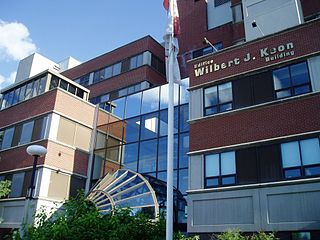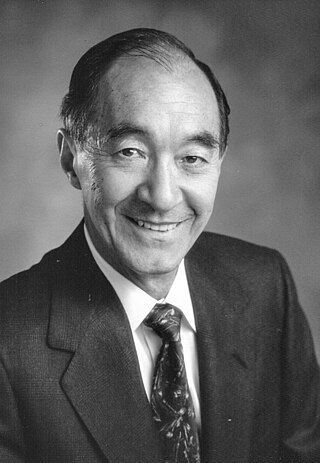Related Research Articles

William Castle DeVries is an American cardiothoracic surgeon, mainly known for the first transplant of a TAH using the Jarvik-7 model.

An artificial heart is an artificial organ device that replaces the heart. Artificial hearts are typically used to bridge the time to complete heart transplantation surgery, but research is ongoing to develop a device that could permanently replace the heart in the case that a heart transplant is unavailable or not viable. As of December 2023, there are two commercially available full artificial heart devices; in both cases, they are for temporary use, of less than a year, for total heart failure patients awaiting a human heart to be transplanted into their bodies.

Denton Arthur Cooley was an American cardiothoracic surgeon famous for performing the first implantation of a total artificial heart. Cooley was also the founder and surgeon in-chief of The Texas Heart Institute, chief of Cardiovascular Surgery at clinical partner Baylor St. Luke's Medical Center, consultant in Cardiovascular Surgery at Texas Children's Hospital and a clinical professor of Surgery at the University of Texas Health Science Center at Houston.

The University of Ottawa Heart Institute (UOHI) (French: Institut de cardiologie de l'Université d'Ottawa ) is Canada's largest cardiovascular health centre. It is located in Ottawa, Ontario, Canada. It began as a department in The Ottawa Hospital, and since has evolved into Canada's only complete cardiac centre, encompassing prevention, diagnosis, treatment, rehabilitation, research, and education.

A ventricular assist device (VAD) is an electromechanical device that provides support for cardiac pump function, which is used either to partially or to completely replace the function of a failing heart. VADs can be used in patients with acute or chronic heart failure, which can occur due to coronary artery disease, atrial fibrillation, valvular disease, and other conditions.

Willem Johan "Pim" Kolff was a pioneer of hemodialysis, artificial heart, as well as in the entire field of artificial organs. Willem was a member of the Kolff family, an old Dutch patrician family. He made his major discoveries in the field of dialysis for kidney failure during the Second World War. He emigrated in 1950 to the United States, where he obtained US citizenship in 1955, and received a number of awards and widespread recognition for his work.

O. H. "Bud" Frazier is a heart surgeon and director of cardiovascular surgery research at the Texas Heart Institute (THI), best known for his work in mechanical circulatory support (MCS) of failing hearts using left ventricular assist devices (LVAD) and total artificial hearts (TAH).
Jarvik is a surname. Notable people with the surname include:
Murray Elias Jarvik was an American psychopharmacologist and academic who was among the first scientists to study d-lysergic acid, the precursor to LSD, and later became the co-inventor of the nicotine patch. He was a longtime professor emeritus at University of California-Los Angeles, where he taught as a professor of psychiatry and pharmacology for many years.

The University of Utah Hospital is a research and teaching hospital on the campus of the University of Utah in Salt Lake City, Utah. It serves as a major regional referral center for Utah and the surrounding states of Idaho, Nevada, Wyoming, Montana and Colorado. Since 1965, it has grown to become a health care system known as University of Utah Health, which includes five hospitals and twelve community health centers. University of Utah Health is praised for the following specialties: cardiology, geriatrics, gynecology, pediatrics, rheumatology, pulmonology, neurology, oncology, orthopedics, and ophthalmology.
Morton Maimon Mower was an American cardiologist specializing in electrophysiology and the co-inventor of the automatic implantable cardioverter defibrillator. He served in several professional capacities at Sinai Hospital and Cardiac Pacemakers Inc. In 1996, he became the chairman and chief executive officer of Mower Research Associates. He was inducted into the National Inventors Hall of Fame in 2002 for the development of the automatic implantable cardioverter defibrillator with Michel Mirowski in the 1970s. He continued his research in the biomechanical engineering laboratories at Johns Hopkins University.
Bin He is a Chinese American biomedical engineering scientist. He is the Trustee Professor of the Department of Biomedical Engineering, professor by courtesy in the Department of Electrical and Computer Engineering, and Professor of Neuroscience Institute, and was the head of the department of Biomedical Engineering at Carnegie Mellon University. Prior, he was Distinguished McKnight University Professor of Biomedical Engineering and Medtronic-Bakken Endowed Chair for Engineering in Medicine at the University of Minnesota. He previously served as the director of the Institute for Engineering in Medicine and the Center for Neuroengineering at the University of Minnesota. He was the Editor in Chief of the IEEE Transactions on Biomedical Engineering and serves as the editor in chief of IEEE Reviews in Biomedical Engineering. He was the president of the IEEE Engineering in Medicine & Biology Society (EMBS) from 2009 to 2010 and chair of International Academy of Medical and Biological Engineering from 2018 to 2021.
The University of Utah Research Park, also known as Bionic Valley, is located on the campus of the University of Utah in Salt Lake City, United States. The facility has helped create many businesses based on the work of university scientists over the years. Research Park now houses more than forty companies alongside sixty-nine academic departments and employs more than 7,500 people. The annual in-state productivity of park residents exceeds $550 million.

The University of Utah School of Medicine is located on the upper campus of the University of Utah in Salt Lake City, Utah. It was founded in 1905 and is currently the only MD-granting medical school in the state of Utah.

Clifford Stanley Kwan-Gett is an Australian-born Chinese American engineer, physician, and artificial heart pioneer.

St. Luke's Health is a health system located in the Greater Houston area. It is a part of one of the largest health systems and the second largest faith-based health system in the United States, Catholic Health Initiatives. CHI St. Luke's Health's facilities have been recognized as some of the best in the nation.
Jed Eugene Rose is an American academic professor, inventor and researcher in the field of nicotine and smoking cessation. Rose is presently the President and CEO of the Rose Research Center, LLC in Raleigh, North Carolina. Additionally, he is the Director of the Duke Center for Smoking Cessation at Duke University Medical Center.
Jack Greene Copeland is an American cardiothoracic surgeon, who has established procedures in heart transplantation including repeat heart transplantation, the implantation of total artificial hearts (TAH) to bridge the time to heart transplant, innovations in left ventricular assist devices (LVAD) and the technique of "piggybacking" a second heart in a person, while leaving them the original.

Lissy Jarvik was a Dutch-born American geriatric psychiatrist. The National Library of Medicine featured her in their interactive "Changing the Face of Medicine" exhibit, describing her as "a pioneer in the field of neuropsychogeriatrics."
References
Inline citations
- ↑ "Men in the News: A Pair of Skilled Hands to Guide an Artificial Heart: Robert Kiffler Jarvik". Article in The New York Times, 3 December 1982. Retrieved from on 2006-06-23.
- ↑ University, Carnegie Mellon. "Jonathan W. Jarvik - Biological Sciences - Carnegie Mellon University". www.cmu.edu. Retrieved 2022-07-16.
- ↑ Maugh II, Thomas (2008-05-14). "Dr. Murray E. Jarvik, 84; UCLA pharmacologist invented nicotine patch". Los Angeles Times . Retrieved 2008-05-26.
- ↑ "Dr. Murray Jarvik, co-inventor of nicotine patch, dies at 84 in Santa Monica". International Herald Tribune. Associated Press. 2008-05-10. Retrieved 2008-05-26.
- 1 2 "Jarvik, Robert Koffler | Encyclopedia.com". www.encyclopedia.com. Retrieved 2023-08-11.
- ↑ Baumgold, Julie (February 6, 1989). "In the Kingdom of the Brain". New York Magazine. 22 (6): 43.
- 1 2 "Milestones". Rime Magazine, March 2, 2009 p.18
- ↑ "Men in the News: A Pair of Skilled Hands to Guide an Artificial Heart: Robert Kiffler Jarvik". Article in The New York Times, 3 December 1982. Retrieved from on 2007-05-27.
- ↑ "Is this celebrity doctor's TV ad right for you?". Article in NBC News, 1 March 2007. Retrieved from on 2007-05-27.
- ↑ "Salem Press". Archived from the original on 2010-11-28. Retrieved 2010-06-14. Great Lives from History: Inventors and Inventions -- Robert Jarvik
- ↑ Liotta/Cooley "Orthotopic Cardiac Prosthesis for Two-Staged Cardiac Replacement," which appears in Volume 24 (1969) of the American Journal of Cardiology (pp. 723-730).
- ↑ Artificial Heart – Early developments
- ↑ "Golden Plate Awardees of the American Academy of Achievement". www.achievement.org. American Academy of Achievement.
- ↑ "Congress questions Jarvik's credentials in celebrity ad" The State, January 8, 2008. http://www.thestate.com/nation/story/278107.html%5B%5D
- ↑ American Medical Association Journal of Ethics October 2010, Volume 12, Number 10: 818-823
- ↑ Bazell, Robert (1 March 2007). "Is this celebrity doctor's TV ad right for you?". NBC News. Archived from the original on December 3, 2013.
- 1 2 "A Man Enters". Utah Stories. 2011-11-03. Retrieved 2020-02-23.
- ↑ Gonzales, Laurence (1989). The Still Point . University of Arkansas Press. p. 47. ISBN 978-1-55728-081-7.
Elaine Levin Jarvik.
- ↑ "About Marilyn". Archived from the original on 2006-05-07. Retrieved 2007-11-03.
- ↑ Brother Paul's Mormon Bathroom Reader
- ↑ Skousen, Paul B.; Moon, Harold K. (November 1, 2005), Brother Paul's Mormon Bathroon Reader, Cedar Fort, p. 39. Archived at Google Books. Retrieved March 21, 2016.
General references
- Frazier, O H; Myers, T J; Jarvik, R K; Westaby, S; Pigott, D W; Gregoric, I D; Khan, T; Tamez, D W; Conger, J L; Macris, M P (2001). "Research and development of an implantable, axial-flow left ventricular assist device: the Jarvik 2000 Heart". Ann. Thorac. Surg. Vol. 71, no. 3 Suppl (published Mar 2001). pp. S125–32, discussion S144–6. doi:10.1016/S0003-4975(00)02614-X. PMID 11265847.
- Jarvik, R K; Lawson, J H; Olsen, D B; Fukumasu, H; Kolff, WJ (1978). "The beat goes on: status of the artificial heart, 1977". The International Journal of Artificial Organs. Vol. 1, no. 1 (published Jan 1978). pp. 21–7. PMID 352968.